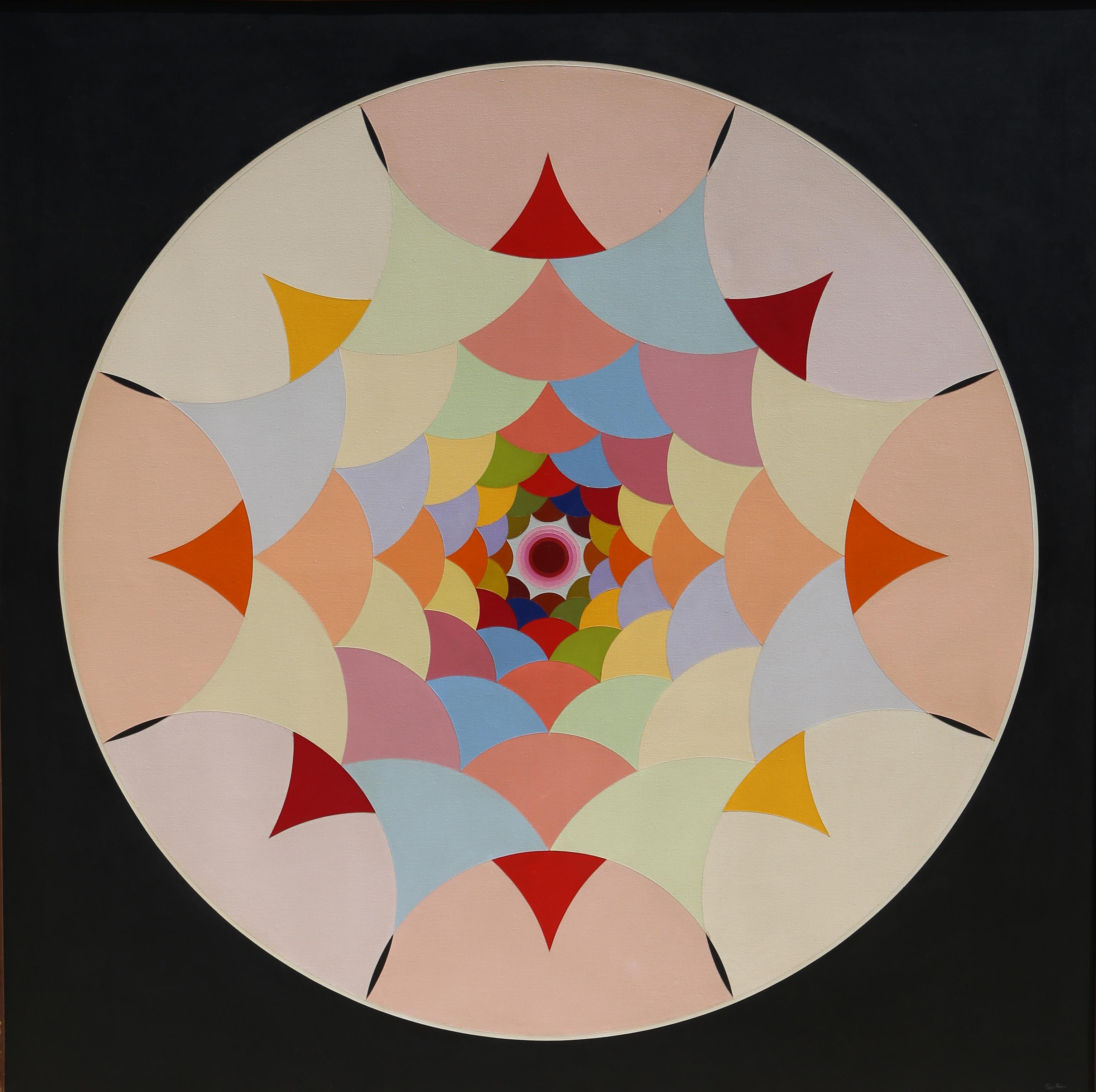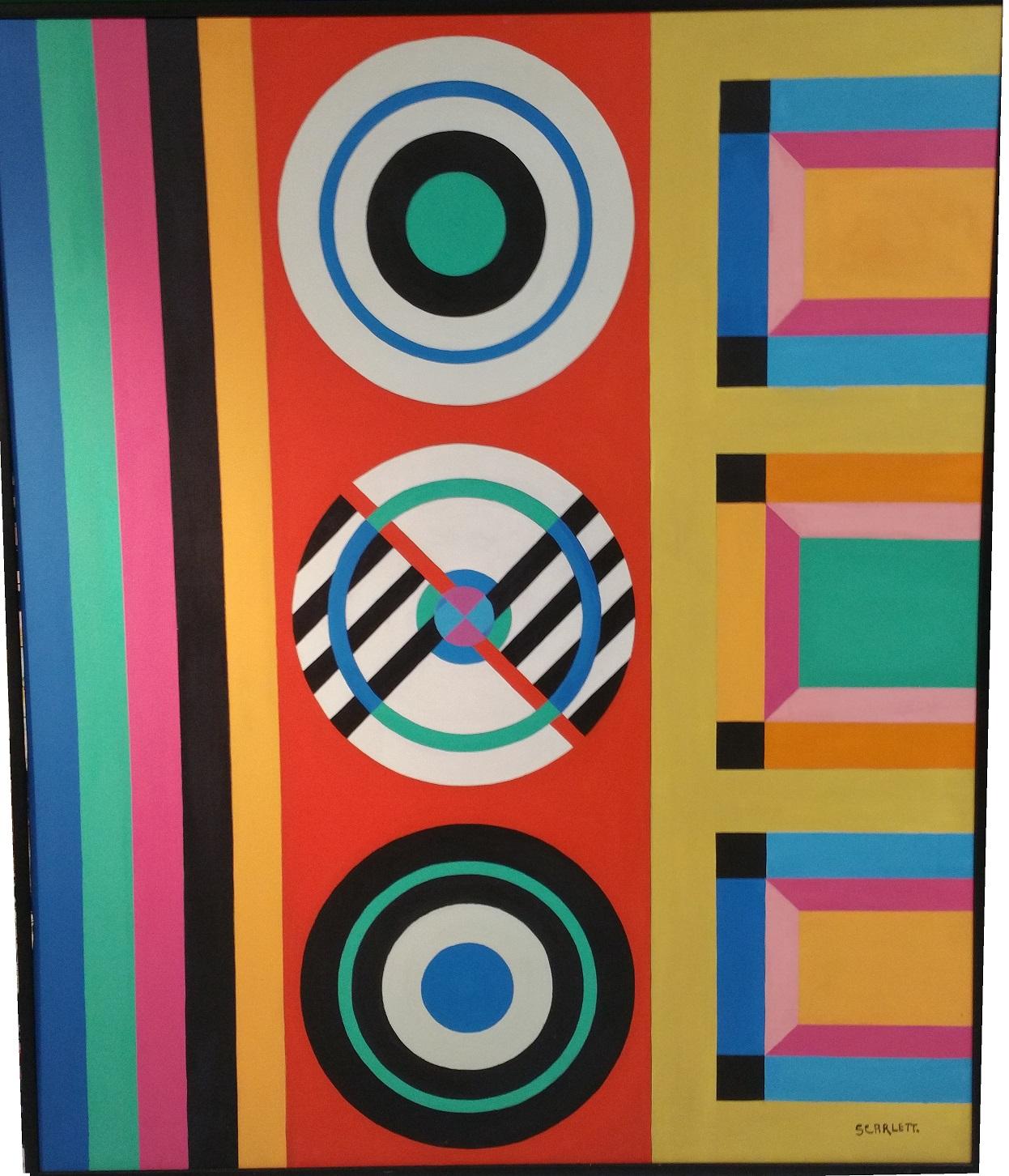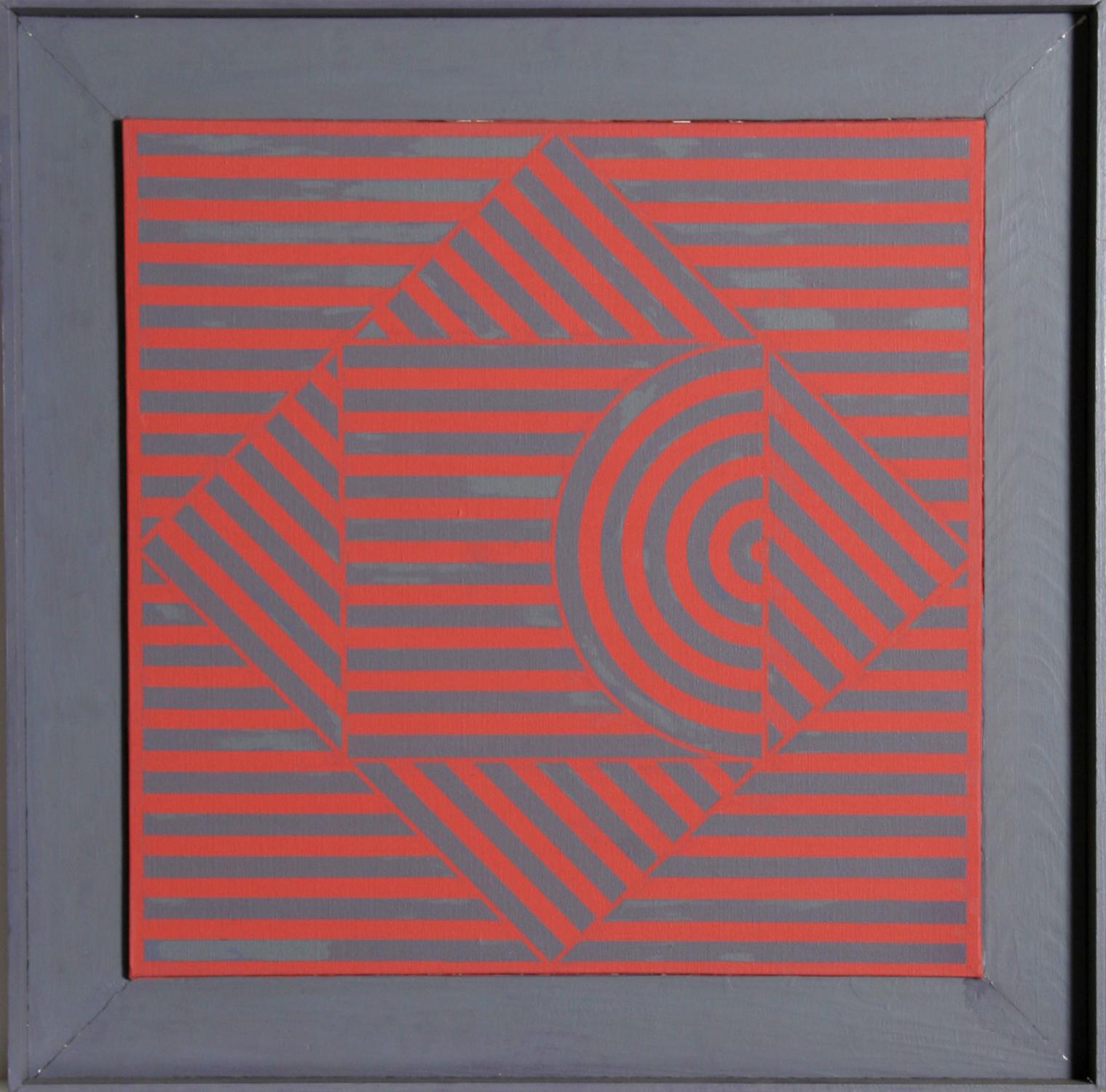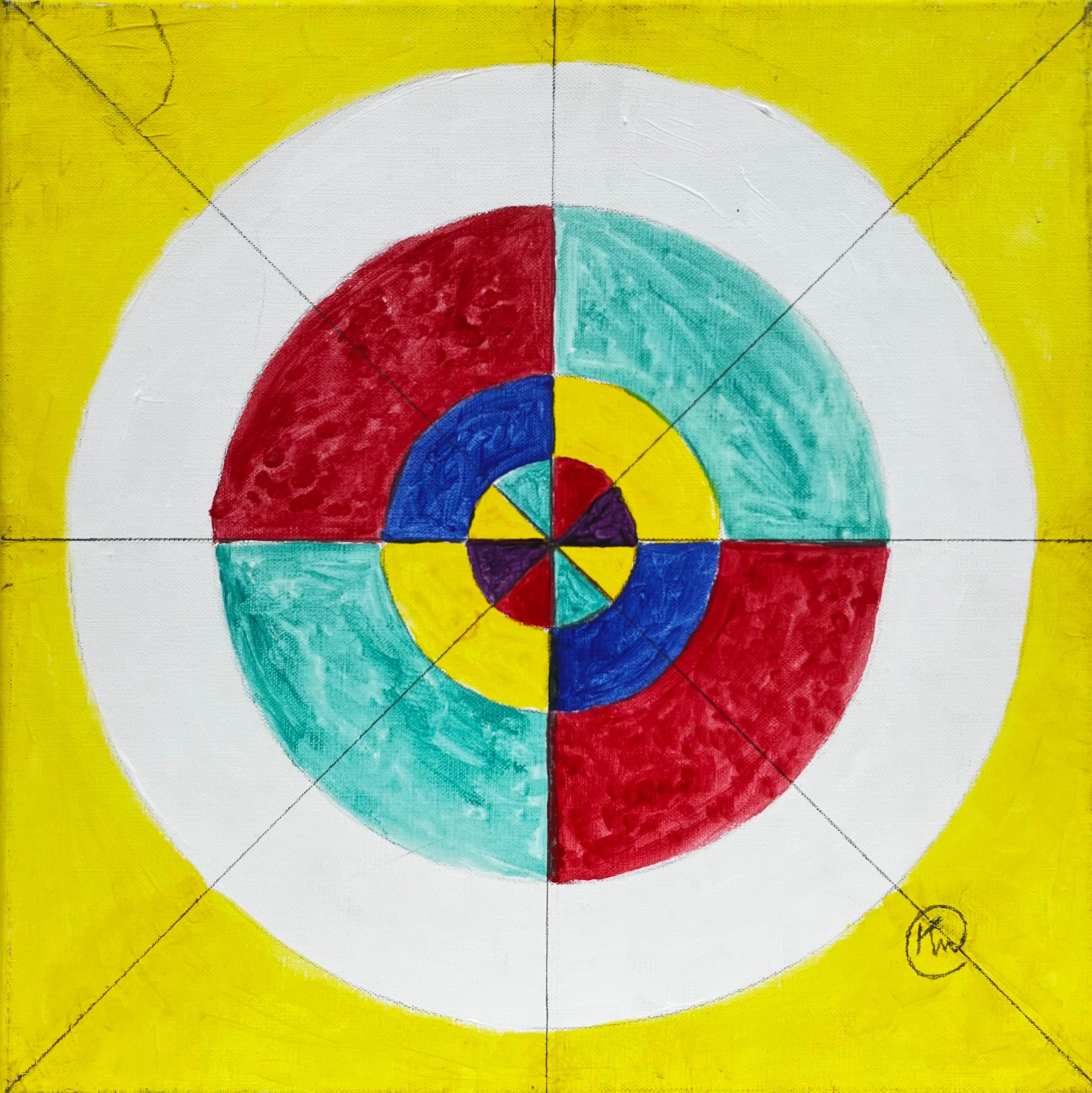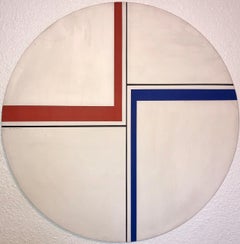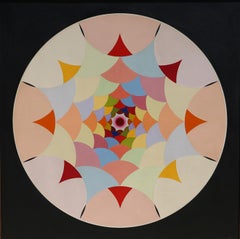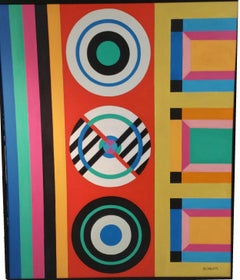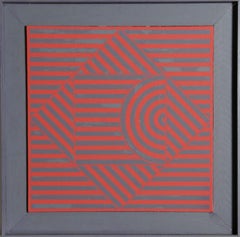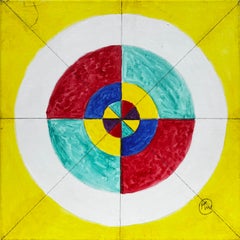Items Similar to Op Art Hard Edged Abstract Geometric Mod Painting John Pearson
Want more images or videos?
Request additional images or videos from the seller
1 of 19
John PearsonOp Art Hard Edged Abstract Geometric Mod Painting John Pearson1985
1985
$2,800
£2,171.65
€2,461.48
CA$4,007.28
A$4,378.78
CHF 2,270.11
MX$52,310.77
NOK 28,888.48
SEK 27,046.47
DKK 18,380.36
About the Item
John Pearson (American born 1940)
"Study for Circus"
1985
Acrylic on canvas painting
Hand signed verso, hangs from corner of canvas.
Provenance: The New Gallery of Contemporary Art, Cleveland, Ohio. Bearing label verso:
Dimensions: 19 x 19 in (it hangs in diamond shape which measures point to point 26.87 X 26.87 inches)
Red, White, Blue, and Yellow abstract geometric painting. Circle and ellipse.
John Pearson (British, 1940-was born in Yorkshire, England, and studied at the Harrogate School of Art, Yorkshire (National Diploma of Design, 1960), the Royal Academy Schools, London (Certificate, R.A.S 1963), the Akademie der Bildenden Kunst, Munich (1963–64, research fellow), and Northern Illinois University (M.F.A. 1966). He is known for hard edged, mod abstract oil painting on shaped canvas in geometric, curvilinear forms.
For many years, Pearson has made paintings and low-relief sculpture, predominantly wall pieces, which use color, form, and various degrees of abstraction to modify the space of entire rooms. With work exhibited nationally and internationally in both solo and group shows, Pearson has also been sought for many site-specific commissions, both public and private. These are typically highly abstract, simplified, and nuanced; they’re often witty, too.
Pearson early on became a devotee of the Dutch artist Piet Mondrian, a chief proponent of De Stijl (The Style), Pearson’s style has evolved from intense system-based abstract compositions to one more attuned to the spiritual influences of the natural environment. Pearson’s early style reflects the European reaction to expressionism and artistic emotionalism in the form of a rational, systematic approach to art (often called the “New Tendency”). An heir to the tenets of Constructivism, he investigated color within a predetermined linear or grid system that eliminated options after the artist’s initial choices. He was drawn to Cleveland in 1970 because of its reputation at the time for having a rich environment for abstract art, as two of the chief proponents of Kinetic art and op art, Julian Stanczak and Richard Anuszkeiwicz, worked there. Students of Josef Albers, the grand master of color theory who taught these two primary practitioners of the “Color Function” school of abstract art at Yale in the 1950s.
Pearson’s early style reflects a European reaction to abstract expressionism that manifested itself in a rational, systematic approach to art.Since his emergence in 1960s London, John Pearson has been using mathematical systems and computer programs to generate hard-edged geometric compositions. His work is of the same genre as the artists of the Denise Rene Gallery in Paris, similar to Vasarely, Agam, Cruz Diez and Soto. His most recent work, with its circles and ellipses superimposed on patterns of wavy lines, brings a more easygoing approach to his particular breed of rule-based art. Pearson has received grants from the National Endowment for the Arts and the Canada Council, and has had solo exhibitions at institutions including the Akron Art Museum, the Cleveland Center for Contemporary Art, and the Museum of Modern Art in Rijeka, Croatia. Pearson was born in Yorkshire (Britain) and studied art at the Royal Academy Schools in London, did advanced work in Munich (Germany), and earned the M.F.A. (Master of Fine Arts) degree from Northern Illinois University. Before arriving to teach at Oberlin College in 1972, he taught at the University of New Mexico, the Nova Scotia College of Art and Design, and the Cleveland Institute of Art. At Oberlin, he served as the Young-Hunter Professor of Art. John retired from teaching in 2014 but still occasionally works with students and lives in Oberlin where he educated several generations of appreciative liberal arts students. He also served as department chair and held the Young-Hunter endowed professorship from 1987 onward, until his retirement. Pearson travelled widely to paint, exhibit, and teach and received support from the Ohio Arts Council and the National Endowment for the Arts, among others. His career received recognition via the Cleveland Arts Prize in 1975, while most recently he was recognized as a Special Honoree by the same organization.
His paintings and sculptures are held in many public and private collections in the U.S., Canada, Europe, China, and Japan, as well as by museums, such as the Allen Art Museum (Oberlin), the Cleveland Museum of Art, the Museum of Modern Art (New York), and the Art Institute of Chicago. Hard-Edged
Select Group Exhibitions
Abstract, Constructive, Concrete Mondrian huis, Amersfoort, Holland
Chronologic Planet Art Gallery, Capetown, South Africa
The INTERNATIONAL PRINT BIENNIAL Machida Museum of Graphic Arts, Tokyo
Cleveland Collects Contemporary Art The Cleveland Museum of Art
From Durer to Dine Contemporary Art Center, Cincinnati, OH
2nd International Invitational Print Expo Lenin Museum, Kiev, Ukraine
Arc, Circle, Square: Josef Albers, Mel Bochner, Al Held, Donald Judd, The Mary Ryan Gallery, NYC
Les Levine, Sol Lewitt, Robert Mangold, Brice Marden, John Pearson, Andrew Spence)
Digital Visions: Computers & Art IBM Science & Art Gallery, NYC, and
The Center for Fine Arts, Miami, Florida
ArtWare: Kunst und Elektronik Kunst Museum, Munich, Germany & Karl Ernst Osthaus Museum, Hagen, Germany Trends in Geometric Art The Tel Aviv Museum of Art, Israel
American Drawing 1963-1973 The Whitney Museum of American Art, NYC
Chicago & Vicinity The Art Institute of Chicago, Chicago, ILL
75 Years of British Art Molton Gallery, London, England
Select Museum Collections
Museum of Modern Art MoMA NYC
LACMA Los Angeles
National Gallery of Art, Washington, DC
Pasadena Museum of Fine Arts, Pasadena, California
Zhejiang Academy of Fine Arts, Hangzhou, China
Art Institute of Chicago, Chicago, Illinois
Amon Carter Museum, Fort Worth, Texas
Kleye Kunstverein, Dortmund, Germany
Louisiana Museum of Art, Humlebaek, Denmark
Museum of Modern Art, New York U.S. Consulate, Osaka, Japan
Tel Aviv Museum of Fine Arts, Tel Aviv, Israel
- Creator:John Pearson (British, American)
- Creation Year:1985
- Dimensions:Height: 26.87 in (68.25 cm)Width: 26.87 in (68.25 cm)
- Medium:
- Movement & Style:
- Period:
- Condition:Please see photos.
- Gallery Location:Surfside, FL
- Reference Number:1stDibs: LU38217144532
About the Seller
4.9
Platinum Seller
Premium sellers with a 4.7+ rating and 24-hour response times
Established in 1995
1stDibs seller since 2014
1,833 sales on 1stDibs
Typical response time: 1 hour
- ShippingRetrieving quote...Shipping from: Surfside, FL
- Return Policy
More From This Seller
View AllLarge Modernist Geometric Abstract Painting
By Gregg Robinson
Located in Surfside, FL
Gregg Robinson, American (born 1948) "Cipher Bar 19" Oil on Canvasboard Panel. Artist signed, title and dated 1990 far right. Very minor rubbing to paint. Panel measures 15-1/4" H x 63-1/2" W, frame measures 24-1/4" H x 72-1/4" W
GREGG ROBINSON
The universe of visual art encompasses a huge spectrum of motivation and means of expression. Examples range from the most syrupy sentimentality to extremes of moral and intellectual confrontation. For me, the creative process is, on the simplest level, an aesthetic puzzle. Elements of the puzzle include contrast, color, visual texture, graphic pattern, and in some recent work, a simple cryptic symbolism.
I have never been particularly interested in lyric or pictorial content, and though some of my work does contain undeniable spatial illusion, even that tends to be a by-product rather than a goal of the primary pursuit: the balance of light and dark, pure color and organic neutrals, energy and calm, strong pattern and subtle field. Having grown up in an environment of contemporary architecture, I have always valued the classic modern synthesis of form and function exemplified by the Bauhaus movement of the early 20th century. Hence, the simplest solutions are often the most satisfying. Obviously, the modernist ideal of efficiency in form and function requires that method of execution be as well adapted to the aesthetic goal as the visual language itself.
The media before you is the result of many years of experimentation that came to its current form in early 1992. I work with dry pigment over a plaster surface. My tools are broad knives, sponges, rags and masking. The finish is a high gloss alkyd resin.
CORPORATE COLLECTIONS:
Allstate Insurance
NBC Productions
Alaska...
Category
1990s Contemporary Abstract Paintings
Materials
Canvas, Mixed Media, Oil, Board
1972 Abstract Oil Painting Homage to Ilya Bolotowskiy Hard Edged Abstraction
By Johnathan Singer
Located in Surfside, FL
This work takes its cues from Ilya Bolotowsky and Piet Mondrian. A fine example of 1970's hard edged geometric abstraction.
Artist, painter & master photographer Jonathan Singer was...
Category
1970s Abstract Geometric Abstract Paintings
Materials
Canvas, Oil
Large Modernist Abstract Painting (1of 2 available)
By Gregg Robinson
Located in Surfside, FL
Gregg Robinson, American (born 1948) "Cipher Bar 20" Oil on Canvasboard Panel. Artist signed, title and dated 1990 far right. Very minor rubbing to paint. Panel measures 15-1/4" H x 63-1/2" W, frame measures 24-1/4" H x 72-1/4"
GREGG ROBINSON
The universe of visual art encompasses a huge spectrum of motivation and means of expression. Examples range from the most syrupy sentimentality to extremes of moral and intellectual confrontation. For me, the creative process is, on the simplest level, an aesthetic puzzle. Elements of the puzzle include contrast, color, visual texture, graphic pattern, and in some recent work, a simple cryptic symbolism.
I have never been particularly interested in lyric or pictorial content, and though some of my work does contain undeniable spatial illusion, even that tends to be a by-product rather than a goal of the primary pursuit: the balance of light and dark, pure color and organic neutrals, energy and calm, strong pattern and subtle field. Having grown up in an environment of contemporary architecture, I have always valued the classic modern synthesis of form and function exemplified by the Bauhaus movement of the early 20th century. Hence, the simplest solutions are often the most satisfying. Obviously, the modernist ideal of efficiency in form and function requires that method of execution be as well adapted to the aesthetic goal as the visual language itself.
The media before you is the result of many years of experimentation that came to its current form in early 1992. I work with dry pigment over a plaster surface. My tools are broad knives, sponges, rags and masking. The finish is a high gloss alkyd resin.
CORPORATE COLLECTIONS:
Allstate Insurance
NBC Productions
Alaska...
Category
1990s Contemporary Abstract Paintings
Materials
Canvas, Mixed Media, Oil, Board
Jean Marie Haessle Abstract Geometric Op Art Silkscreen Lithograph Print
By Jean-Marie Haessle
Located in Surfside, FL
Jean Marie Haessle, French-American (1939-)
Serigraph silkscreen
Hand signed in pencil and numbered
Elana's Dream (red background)
1980
Jean Marie Haessle was born in 1939 in Alsa...
Category
1980s Abstract Geometric Abstract Prints
Materials
Lithograph, Screen
French Post War Geometric Abstract Oil Painting Kinetic Op Art Edgard Pillet
Located in Surfside, FL
Edgard Pillet (French, 1912-1996).
Modern Abstract oil painting on canvas.
Titled "Olifant". A vibrant work featuring colors of purple, pinks and blues...
Category
1990s Post-Modern Abstract Paintings
Materials
Canvas, Oil
Op Art 1971 Kinetic Oil Painting Pop Art Artist
By Josef Levi
Located in Surfside, FL
Josef Alan Levi (1938) is an American artist whose works range over a number of different styles, but which are unified by certain themes consistently present among them. Josef Levi began his artistic career in the 1960s and early '70s, producing highly abstract and very modernist pieces: these employing exotic materials such as light fixtures and metallic parts. By 1975, Levy had transitioned to painting and drawing still lifes. At first these were, traditionally, of mundane subjects. Later, he would depict images from art history, including figures originally created by the Old Masters. Around 1980, he made another important shift, this time toward creating highly precise, though subtly altered reproductions of pairs of female faces which were originally produced by other artists. It is perhaps this work for which he is most well known. Since around 2000, Josef Levi has changed the style of his work yet again: now he works entirely with computers, using digital techniques to abstract greatly from art history, and also from other sources.
Levi's works of art in the collections of the Museum of Modern Art, NYC, the National Gallery of Art, and the Albright-Knox Museum, among many others. Levi's art has been featured on the cover of Harper's Magazine twice, once in June 1987, and once in May 1997.
Josef Levi received a Bachelor of Arts degree in 1959 from the University of Connecticut, where he majored in fine arts and minored in literature. From 1959 to 1960, he served to a first lieutenant in the U.S. Army, and from 1960 through 1967 he was in the U.S. Army Reserves.
In 1966, he received the Purchase Award from the University of Illinois in 1966, and he was featured in New Talent U.S.A. by Art in America. He was an artist in residence at Appalachian State University in 1969, taught at Farleigh Dickenson University in 1971 and was a visiting professor of art at Pennsylvania State University in 1977. From 1975 to 2007, Levi resided in New York City. He now lives in an apartment in Rome, where he is able to paint with natural light as he was unable in New York.
From 1959 to 1960, Josef took some courses of Howard McParlin Davis and Meyer Schapiro at Columbia University which initiated him into the techniques of reproducing the works of the Old Masters. His first works, created in the 1960s, were wood and stone sculptures of women. His first mature works were abstract pieces, constructed of electric lights and steel.
In 1970, Levi's materials included fluorescent light bulbs, Rust-Oleum and perforated metal in addition to paint and canvas.
By 1980, Josef Levi's art had transformed into a very specific form: a combination of reproductions of female faces which were originally depicted by other artists. The faces which he reproduces may be derived from either portraits or from small portions of much larger works; they are taken from paintings of the Old Masters, Japanese ukiyo-e, and 20th-century art. Artists from whom he has borrowed include: Vermeer, Rembrandt, Piero della Francesca, Botero, Matisse, Utamaro, Correggio, Da Vinci, Picasso, Chuck Close, Max Beckmann, Pisanello, Lichtenstein. The creation of these works is informed by Levi's knowledge and study of art history.
Josef Levi's paintings from this period are drawn, then painted on fine linen canvas on wooden stretchers. The canvas is coated with twenty-five layers of gesso in order to produce a smooth surface on which to work. The drawing phase takes at least one month. Levi seals the drawing with acrylic varnish, and then he may apply layers of transparent acrylic in order to approximate the look of old paintings. After the last paint is applied, another layer of acrylic varnish is sprayed on to protect the work.
Most of the figures in his contemporary pieces are not paired with any others.
SELECTED COLLECTIONS
MUSEUM OF MODERN ART, NEW YORK, NY
ALBRIGHT- KNOX GALLERY, BUFFALO, NY
ALDRICH MUSEUM OF CONTEMPORARY ART, RIDGEFIELD, CT
NATIONAL GALLERY OF ART, WASHINGTON, DC
BROOKLYN MUSEUM OF ART, BROOKLYN, NY
SMITHSONIAN NATIONAL MUSEUM OF AMERICAN HISTORY, WASHINGTON, DC
CORCORAN GALLERY, WASHINGTON, DC
UNIVERSITY OF NOTRE DAME ART...
Category
1970s Op Art Abstract Paintings
Materials
Canvas, Oil
You May Also Like
Sun in Clouds, Large Geometric Abstract Acrylic Painting by Max Epstein
By Max Epstein
Located in Long Island City, NY
Artist: Max Epstein, Canadian (1932 - 2002)
Title: Untitled
Year: 1973
Medium: Acrylic on Canvas, signed and dated verso
Size: 67 x 67 inches
Frame Size: 68 x 68 in. (172.72 x 172.72...
Category
1970s Op Art Abstract Paintings
Materials
Acrylic
Geometric Abstract
By Rolph Scarlett
Located in Saratoga Springs, NY
Signed lower left.
About the artist:
Rolph Scarlett was a painter of geometric abstraction during the American avant-garde movement of the 1930s and 1940s. Born in Guelph, Ontario,...
Category
1960s Abstract Geometric Abstract Paintings
Materials
Canvas, Oil
Variants, Abstract Geometric Acrylic Painting by Irwin McFadden
By Irwin McFadden
Located in Long Island City, NY
Artist: Irwin McFadden, American
Title: Variants
Year: 1972
Medium: Acrylic on Canvas, signed and dated verso
Size: 19.5 in. x 19.5 in. (49.53 cm x 49.53 cm)
Frame Size: 25 x 25 inches
Category
1970s Abstract Geometric Abstract Paintings
Materials
Acrylic
Abstract Geometric Composition, Modern British Painting
Located in Cirencester, Gloucestershire
Artist/ School: Modern British contemporary
Title: Geometric Abstract composition
Medium: acrylic on canvas , unframed
Canvas : 15.5 x 15.5 inches
...
Category
19th Century Abstract Geometric Abstract Paintings
Materials
Acrylic
$1,878 Sale Price
30% Off
Hexagon, Large Geometric Abstract Acrylic Painting by Arthur Boden
By Arthur Boden
Located in Long Island City, NY
Artist: Arthur Boden, American XXth
Title: Untitled (Hexagon)
Year: 1975
Medium: Acrylic on Canvas, signed verso
Size: 54 x 51.5 (104.14 cm x 152.4 cm)
Category
1970s Op Art Abstract Paintings
Materials
Canvas, Acrylic
Aperture, Op Art Geometric Abstract Oil Painting by Roy Ahlgren
By Roy Ahlgren
Located in Long Island City, NY
Artist: Roy Ahlgren, American (1927 - 2011)
Title: Aperture
Year: 1976
Medium: Acrylic on Canvas, signed verso
Size: 30 x 30 in. (76.2 x 76.2 cm)
Category
1970s Op Art Abstract Paintings
Materials
Oil
